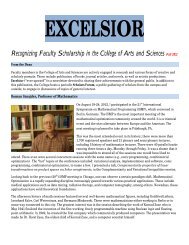You also want an ePaper? Increase the reach of your titles
YUMPU automatically turns print PDFs into web optimized ePapers that Google loves.
Xseed <strong>User</strong> Manual<br />
1.) How to compile and run the MPI program without queuing system<br />
2.) How to submit a job to queuing system<br />
3.) How to submit MPI program to queuing system<br />
MPI<br />
In /apps/MPI_users_help/MPI_examples/ there are some examples (simple mpi apps in c,<br />
c++, and fortran). Copy the files from directory to your directory first using:<br />
mkdir ~/MPI/<br />
mkdir ~/MPI/examples/<br />
cp /apps/MPI_users_help/MPI_examples/* ~/MPI/examples/<br />
cd ~/MPI/examples<br />
Now you have the examples in your directory: /home/$user/MPI/examples. And you are<br />
in this directory too.<br />
Setup environment: - not necessary with runmpi script<br />
To launch the MPI applications from xseed1 the environment must be set up:<br />
export MXMPI_MASTER=10.224.0.1<br />
Make a machine file:<br />
Machine file is a file with every node name you want use listed 1 per line. It would look like<br />
this:<br />
Node1<br />
node1<br />
node2<br />
node2<br />
...<br />
node224<br />
node224
Nodes are listed twice because there are 2 cpus per machine, if you only want 1 cpu per node,<br />
just list them once.<br />
To generate the machine file there was created a script. The script name is gen and it is<br />
located in the directory:<br />
/apps/MPI_users_help/ or /apps/MPI_users_help/MPI_examples/.<br />
The script has two parameters – the first parameter is the first compute node and second<br />
parameter is the last comp node. The script was already copied to your home directory with<br />
the code examples.<br />
Example of using the script:<br />
./gen 1 20,<br />
will generate the machinefile (machlist.mch) with nodes from 1 to 20.<br />
Compile and run the examples<br />
To compile the examples type:<br />
make<br />
To run one of the examples (cpi.c) use:<br />
./runmpi
MPI – First program – helloworld.c<br />
Copy the hello.c source code, Makefile and the rest of necessary files to your directory<br />
using:<br />
mkdir ~/MPI/<br />
mkdir ~/MPI/helloworld/<br />
cp /apps/MPI_users_help/helloworld/* ~/MPI/helloworld/<br />
cd ~/MPI/helloworld<br />
The content of the directory is:<br />
gen<br />
- machinefile generator<br />
hello.c - helloworld source code<br />
machlist.mch - machine file<br />
Makefile - makefile – to compile to source code<br />
runmpi<br />
- program execution script<br />
Edit the source code:<br />
vi hello.c<br />
Compile the program<br />
Create (or edit) the Makefile to compile the source code:<br />
vi Makefile<br />
The Makefile looks like this:<br />
CC<br />
= /opt/mpich-mx/bin/mpicc<br />
CCC<br />
= /opt/mpich-mx/bin/mpicxx<br />
F77<br />
= /opt/mpich-mx/bin/mpif77<br />
CLINKER = /opt/mpich-mx/bin/mpicc<br />
CCLINKER = /opt/mpich-mx/bin/mpicxx<br />
FLINKER = /opt/mpich-mx/bin/mpif77<br />
F90<br />
= /opt/mpich-mx/bin/mpif90<br />
F90LINKER = /opt/mpich-mx/bin/mpif90<br />
MAKE = make --no-print-directory<br />
SHELL = /bin/sh<br />
EXECS = hello #name of your source code without extension (e.g. hello.c)<br />
all:<br />
$(CC) -o $(EXECS) $(EXECS).c -lm<br />
clean:<br />
-rm *.o<br />
All you need to change in the Makefile is the name of your program, which is after EXECS.<br />
The name of the program in the example is hello.c (don’t change the file if you want to<br />
compile hello.c)<br />
If you create a Makefile, type<br />
make<br />
to compile the source code.<br />
If you does not want to use the Makefile type<br />
/opt/mpich-mx/bin/mpicc -o hello hello.c –lm<br />
to compile the source code. The example shows how to compile source code hello.c
Run the program<br />
/opt/mpich-mx/bin/mpirun -np -machinefile<br />
./<br />
Example : Script “runmpi”<br />
The example shows the content of the script runmpi which executes the program hello .<br />
export MXMPI_MASTER=10.224.0.1<br />
/opt/mpich-mx/bin/mpirun -np 20 -machinefile machlist.mch ./hello<br />
To run the script use:<br />
./runmpi<br />
This example runs program hello on 10 dual processor machines (20 processes = -np 20).<br />
The machines are specified by machlist.mch file.
Queuing System on Xseed<br />
The Xseed uses the Torque, Maui as queuing and resource management system. The<br />
following manual will show how to use the system from user point of view. It means how to<br />
submit simple or MPI jog to the queue.<br />
How to submit a job to the queue<br />
The job can be submitted to the queue using following script. Few parameters need to be<br />
changed for different jobs. For example number of used compute nodes or estimated time it<br />
will take to finish the job. All important parameters are described in the script. The<br />
highlighted parts of the script should be changed by the user.<br />
#bin!/bin/bash<br />
## The below lines is how much real (wall clock)<br />
## time it will take for your job to finish<br />
## Format is HH:MM:SS<br />
#PBS -lwalltime=00:05:00<br />
## Define how many nodes your job will take<br />
## by changing the number after -lnodes= leave :ppn=2 unchanged.<br />
## In this example it is set to use 10 nodes and each node has 2 cpus.<br />
#PBS -lnodes=10:ppn=2<br />
## Below here enter the commands to start your job.<br />
## cd $PBS_O_WORKDIR – the directory where the script is run<br />
cd $PBS_O_WORKDIR<br />
## The program you want to run. In this case it is only basic script.<br />
date<br />
echo "Hello world!"<br />
sleep 120<br />
date<br />
## End of the program.<br />
exit;<br />
The output of the scripts will not be shown on the console. All outputs are saved to the two<br />
files:<br />
.e - error output<br />
.o - program output
Run MPI program using queuing system<br />
To run the MPI program using Torque and Maui the following script can be used. Before the<br />
script can be run the MPI program must be compiled. The script does not need any machine<br />
list because it takes the machine list from Torque. Highlighted parts of the script should be<br />
changed by the user.<br />
#!/bin/bash<br />
## The below lines is how much real (wall clock)<br />
## time it will take for your job to finish<br />
## Format is HH:MM:SS<br />
#PBS -lwalltime=00:05:00<br />
## Define how many nodes your job will take<br />
## by changing the number after -lnodes= leave :ppn=2 unchanged.<br />
## In this example it is set to use 10 nodes and each node has 2 cpus.<br />
#PBS -lnodes=10:ppn=2<br />
## The following lines are for the MPI it self<br />
## Gives to the MPI number of nodes which will be used<br />
NUM_NODES=`cat $PBS_NODEFILE | wc -l | sed "s/ //g"`<br />
## run the MPI program “/home/kutik/mpi/examples/cpi”<br />
/opt/mpich-mx/bin/mpirun -np $NUM_NODES -machinefile $PBS_NODEFILE<br />
/home/kutik/mpi/examples/cpi<br />
Run the script<br />
/apps/packages/torque-2.3.2/bin/qsub qsubtest.sh







